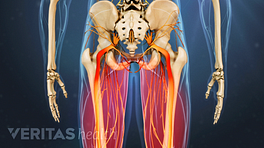The spine condition called isthmic spondylolisthesis occurs when one vertebral body slips forward on the one below it because of a small fracture in a piece of bone that connects the two joints on the back side of the spinal segment.
The fracture in this small piece of bone, called the pars interarticularis, is caused by stress to the bone. While the fracture tends to occur most commonly when an individual is young (around 5 to 7 years old), for most people symptoms typically do not develop until adulthood. There is another spike in occurrence of lower back pain from spondylolisthesis in adolescence.
Watch: Isthmic Spondylolisthesis Video
It is estimated that 5 to 7% of the population has either a fracture in this small piece of bone (a fracture of the pars interarticularis) or a spondylolisthesis (slipped vertebral body), but in most cases there are no symptoms.1 It has been estimated that 80% of people with a spondylolisthesis will never have symptoms, and if it does become symptomatic, only 15 to 20% will ever need surgical correction.
Spondylolisthesis Causes
The pars interarticularis (latin for "bridge between two joints") connects the facet joint above to the one below. It is a thin piece of bone with a poor blood supply, which makes it susceptible to stress fractures. There also can be a fracture of the pars interarticularis without a vertebral slip. The fracture itself is known as a spondylolysis. The pars interarticularis may also be referred to as the isthmus.
See Spondylolysis and Spondylolisthesis
When this small bone fractures it usually does not cause pain or other symptoms. Trauma is not a common reason for fracturing. The fracture is usually due to cumulative stress, analogous to taking a paper clip and bending it multiple times. It will eventually break apart after enough stress.
Isthmic spondylolisthesis occurs most commonly in the L5-S1 level of the spine, the lowest level of the lumbar spine. It does happen rarely above this level, at L4-L5 or L3-L4, but at these levels trauma (rather than cumulative stress) is a more common cause of the fracture.
A fracture has not ever been found in a newborn so it is not considered a congenital problem. The slip that results from having the fracture is most likely to progress in juvenile or adolescent individuals. Progression of the slippage in adulthood is rare.
More Spondylolisthesis Info:
At L5-S1 there is not usually a lot of instability associated with the condition because there is a large ligament (the sacral ala ligament) that connects the L5 vertebral body to the sacrum, preventing the progression of slippage of L5 on the sacrum.
Spondylolisthesis Grading
The severity of the slippage is usually measured after taking a side-view X-ray, and then graded on a scale of 1 to 4. The slippage is measured from the amount the upper vertebral body slips forward on the lower vertebral body.
| Grade 1 | 25% or less of vertebral body has slipped forward |
| Grade 2 | 26% - 50% |
| Grade 3 | 51% - 75% |
| Grade 4 | 76% - 100% |
Although very rare, a condition called spondyloptosis can occur, whereby the L5 vertebral body slips off the sacrum and into the pelvis. Fortunately, most slips are grade one or grade two, and if they become symptomatic they can be treated without surgery.
References
- 1.Ganju A, "Isthmic Spondylolisthesis," Neurosurgical FOCUS Vol. 13 Issue 1 (2002): 1-6.







